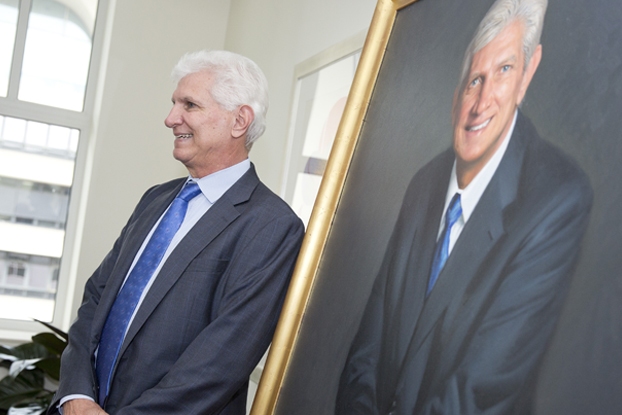Young adults, the recession, and narcissism
 Individuals who enter adulthood during a recession are less likely to be narcissistic, finds Emily Bianchi, assistant professor of organization & management. Using two large, diverse samples of US adults, Bianchi found that people who came of age during periods of high unemployment, specifically during ages 18 through 25, were “more likely to develop an other-oriented and ultimately less narcissistic self-concept.” An additional study similarly found that CEOs who came of age in more difficult economic times exhibited less narcissism than counterparts who came of age in more prosperous economic times. “These findings suggest that macroenvironmental experiences at a critical life stage can have lasting implications for how unique, special, and deserving people believe themselves to be,” she writes. Psychological Science (2014).
Individuals who enter adulthood during a recession are less likely to be narcissistic, finds Emily Bianchi, assistant professor of organization & management. Using two large, diverse samples of US adults, Bianchi found that people who came of age during periods of high unemployment, specifically during ages 18 through 25, were “more likely to develop an other-oriented and ultimately less narcissistic self-concept.” An additional study similarly found that CEOs who came of age in more difficult economic times exhibited less narcissism than counterparts who came of age in more prosperous economic times. “These findings suggest that macroenvironmental experiences at a critical life stage can have lasting implications for how unique, special, and deserving people believe themselves to be,” she writes. Psychological Science (2014).
Product word-of-mouth & the value of disclaimers
 Consumers often rely on word-of-mouth to make decisions on buying a specific product. This is due in part to public exhaustion with the slick and biased messages advertisers often use. But not all word-of-mouth communication is equally persuasive, says Ryan Hamilton, associate professor of marketing, and his co-researchers Ann L. McGill (UChicago) and Kathleen D. Vohs (UMinn). The trio investigated what they term “the dispreferred marker effect,” or the use of disclaimers when a person offers word-of-mouth criticism of a product. They tested the idea in five separate experiments and determined that consumers were more likely to trust product evaluations by other consumers who couched negative criticism in a polite way. The study centered on one kind of dispreferred marker, i.e., idiomatic phrases such as “I’ll be honest” or “I don’t want to be mean, but…” The researchers found that such an approach made the commenter more likeable and appear more credible than those who didn’t offer such a disclaimer. Journal of Consumer Research (2014).
Consumers often rely on word-of-mouth to make decisions on buying a specific product. This is due in part to public exhaustion with the slick and biased messages advertisers often use. But not all word-of-mouth communication is equally persuasive, says Ryan Hamilton, associate professor of marketing, and his co-researchers Ann L. McGill (UChicago) and Kathleen D. Vohs (UMinn). The trio investigated what they term “the dispreferred marker effect,” or the use of disclaimers when a person offers word-of-mouth criticism of a product. They tested the idea in five separate experiments and determined that consumers were more likely to trust product evaluations by other consumers who couched negative criticism in a polite way. The study centered on one kind of dispreferred marker, i.e., idiomatic phrases such as “I’ll be honest” or “I don’t want to be mean, but…” The researchers found that such an approach made the commenter more likeable and appear more credible than those who didn’t offer such a disclaimer. Journal of Consumer Research (2014).
Market reaction to the tone of 10-Ks
 In their research, Narasimhan Jegadeesh, Dean’s Distinguished Chair of Finance and interim vice dean for faculty and research, and Di Wu (UPenn) present a new methodology to investigate just how the positive or negative wording in a company’s financial statements are interpreted by the market. The authors used their “content analysis algorithm” to study all 10-Ks filed from January 1995 through December 2010, using only the 10-Ks that were the first filing for the year by the company. The final sample was a large group, representing 45,860 filings for 7,606 unique firms. The researchers concluded that there was a “significant relation between document tone and market reaction for both positive and negative” of 10-Ks. The study also looked at all IPOs during the 1995 to 2010 period, which included 1,475 IPOs in the sample. The coauthors found a negative relation between the tone of the prospectus and IPO underpricing. Journal of Financial Economics (2013).
In their research, Narasimhan Jegadeesh, Dean’s Distinguished Chair of Finance and interim vice dean for faculty and research, and Di Wu (UPenn) present a new methodology to investigate just how the positive or negative wording in a company’s financial statements are interpreted by the market. The authors used their “content analysis algorithm” to study all 10-Ks filed from January 1995 through December 2010, using only the 10-Ks that were the first filing for the year by the company. The final sample was a large group, representing 45,860 filings for 7,606 unique firms. The researchers concluded that there was a “significant relation between document tone and market reaction for both positive and negative” of 10-Ks. The study also looked at all IPOs during the 1995 to 2010 period, which included 1,475 IPOs in the sample. The coauthors found a negative relation between the tone of the prospectus and IPO underpricing. Journal of Financial Economics (2013).
Organizational failure and job prospects
 Potential employers often evaluate job applicants based on the standing of their current employer. If that employer has failed, even a productive employee can suffer a significant disadvantage when looking for a new position. Giacomo Negro, associate professor of management and organization, and Christopher Rider (Georgetown) used the failure of a prominent law firm in their research to show evidence of this “intraprofessional status loss,” analyzing 224 of the firm’s partners and their transitions to subsequent employers. While the majority of the partners were able to find employment at other law firms, the new firms were on average of lower status than the failed firm. But all employees did not experience the loss of status in the same way. Negro and Rider also found that even after accounting for their productivity, graduates of more prestigious law schools who were displaced were less likely to be negatively impacted. Organizational Science (2014).
Potential employers often evaluate job applicants based on the standing of their current employer. If that employer has failed, even a productive employee can suffer a significant disadvantage when looking for a new position. Giacomo Negro, associate professor of management and organization, and Christopher Rider (Georgetown) used the failure of a prominent law firm in their research to show evidence of this “intraprofessional status loss,” analyzing 224 of the firm’s partners and their transitions to subsequent employers. While the majority of the partners were able to find employment at other law firms, the new firms were on average of lower status than the failed firm. But all employees did not experience the loss of status in the same way. Negro and Rider also found that even after accounting for their productivity, graduates of more prestigious law schools who were displaced were less likely to be negatively impacted. Organizational Science (2014).
Understanding investor behavior
 Prior research indicates that when it comes to trading patterns, investors hold losing positions far too long and sell off winning positions way too soon. Kathryn Kadous, professor of accounting; William Tayler (BYU); Jane Thayer (UVirginia); and Donald Young (Georgia Tech) take the research a step further by disproving the common belief that investor behavior is primarily motivated by “mean reversion,” which is simply the assumption that “losing stocks will bounce back and that winning stocks will fall” over time. Instead, they argue that self-esteem, self-regard, and confidence are the real reasons for this sort of investor behavior. The motivation of investors is complex, so the researchers completed two separate experiments to tease out the differing motivations of investors in losing vs. winning positions. They conclude, “Investors with lower self-regard hold losing investments longer than those with higher self-regard, and investors with higher confidence hold losing investments longer than those with lower confidence.” This implies that feeling good about oneself, in general, and avoiding overconfidence about one’s investing ability jointly allow for better investment decisions. Journal of Behavioral Finance (2014).
Prior research indicates that when it comes to trading patterns, investors hold losing positions far too long and sell off winning positions way too soon. Kathryn Kadous, professor of accounting; William Tayler (BYU); Jane Thayer (UVirginia); and Donald Young (Georgia Tech) take the research a step further by disproving the common belief that investor behavior is primarily motivated by “mean reversion,” which is simply the assumption that “losing stocks will bounce back and that winning stocks will fall” over time. Instead, they argue that self-esteem, self-regard, and confidence are the real reasons for this sort of investor behavior. The motivation of investors is complex, so the researchers completed two separate experiments to tease out the differing motivations of investors in losing vs. winning positions. They conclude, “Investors with lower self-regard hold losing investments longer than those with higher self-regard, and investors with higher confidence hold losing investments longer than those with lower confidence.” This implies that feeling good about oneself, in general, and avoiding overconfidence about one’s investing ability jointly allow for better investment decisions. Journal of Behavioral Finance (2014).
Product differentiation and industry structure
 Much is written about how companies use product differentiation to boost margins or gain market share. But little is known about how firms’ efforts to differentiate their products, individually or jointly, impact their industry’s structure. New research by Richard Makadok, associate professor of organization and management, and David Gaddis Ross (Columbia U.) employs formal modeling to examine how product differentiation can not only shape a firm, but also an industry. The researchers separate two of the effects that product differentiation has on firms’ profits. First, they analyze the “competitive advantage effect” of differentiation and how it increases customers’ willingness to pay for the differentiating firm’s product, thereby raising that firm’s profit at the expense of its rivals. Second, they investigate the “rivalry restraint effect,” or when competitors’ products differ enough from one another to reduce the intensity of price competition among them and, ultimately, raise the profits of all firms in the industry. Since these two effects can either reinforce or counteract each other, competitors may vary in their incentive to differentiate, and they tend to underinvest in differentiation relative to the industry-wide optimum unless they coordinate with each other on their differentiation decisions. Strategic Management Journal (2013).
Much is written about how companies use product differentiation to boost margins or gain market share. But little is known about how firms’ efforts to differentiate their products, individually or jointly, impact their industry’s structure. New research by Richard Makadok, associate professor of organization and management, and David Gaddis Ross (Columbia U.) employs formal modeling to examine how product differentiation can not only shape a firm, but also an industry. The researchers separate two of the effects that product differentiation has on firms’ profits. First, they analyze the “competitive advantage effect” of differentiation and how it increases customers’ willingness to pay for the differentiating firm’s product, thereby raising that firm’s profit at the expense of its rivals. Second, they investigate the “rivalry restraint effect,” or when competitors’ products differ enough from one another to reduce the intensity of price competition among them and, ultimately, raise the profits of all firms in the industry. Since these two effects can either reinforce or counteract each other, competitors may vary in their incentive to differentiate, and they tend to underinvest in differentiation relative to the industry-wide optimum unless they coordinate with each other on their differentiation decisions. Strategic Management Journal (2013).
Measuring brand sentiment on social media
 Large companies increasingly use customer comments on social media for market intelligence. In new research, Wendy Moe (UMaryland) and David Schweidel, associate professor of marketing, argue that these metrics have shortcomings, because they fail to consider structural differences among social media platforms and changes in customer sentiment over time. Taking these differences and changes into account, the two researchers study social media data from firms in two industries, enterprise software and telecommunications, to arrive at a more accurate assessment of customer sentiment. They find that sentiments expressed in various social media platforms evolve in different ways, underscoring the pitfalls of relying on social media comments collected from a single platform. The researchers demonstrate how social media data collected from multiple platforms can be analyzed to better assess brand sentiment, which can serve as an early indicator of shifts in other metrics, such as customer satisfaction surveys and stock prices. Journal of Marketing Research (2014).
Large companies increasingly use customer comments on social media for market intelligence. In new research, Wendy Moe (UMaryland) and David Schweidel, associate professor of marketing, argue that these metrics have shortcomings, because they fail to consider structural differences among social media platforms and changes in customer sentiment over time. Taking these differences and changes into account, the two researchers study social media data from firms in two industries, enterprise software and telecommunications, to arrive at a more accurate assessment of customer sentiment. They find that sentiments expressed in various social media platforms evolve in different ways, underscoring the pitfalls of relying on social media comments collected from a single platform. The researchers demonstrate how social media data collected from multiple platforms can be analyzed to better assess brand sentiment, which can serve as an early indicator of shifts in other metrics, such as customer satisfaction surveys and stock prices. Journal of Marketing Research (2014).












[…] In-depth knowledge of major Nokia Networks radio/core network PM stats , counters and reports […]
[…] In-depth knowledge of infrastructure investment structuring […]